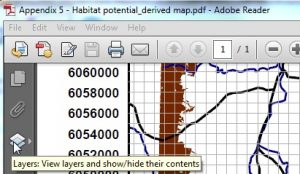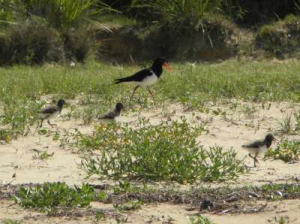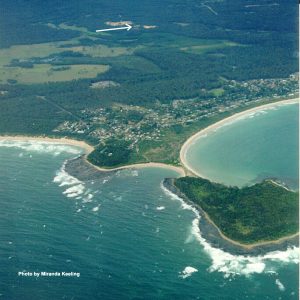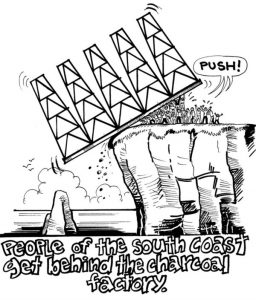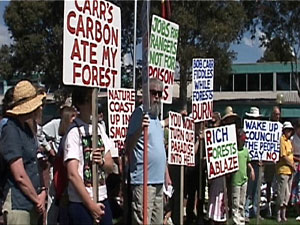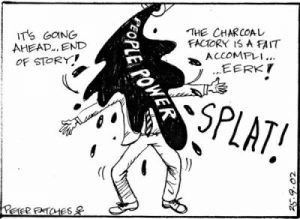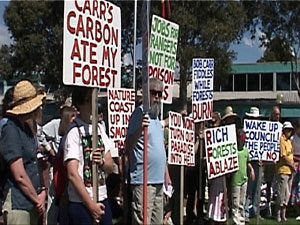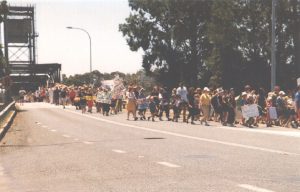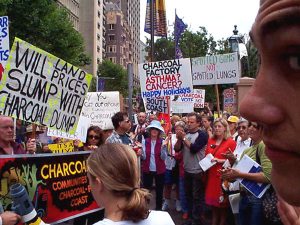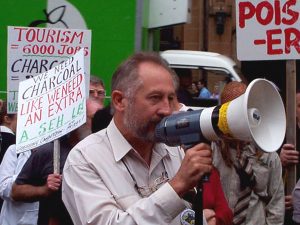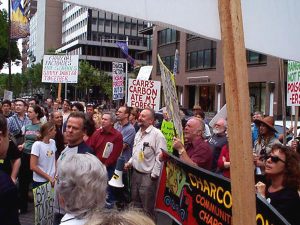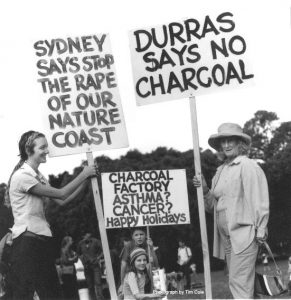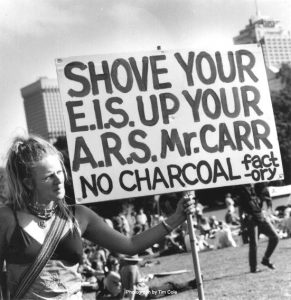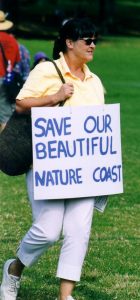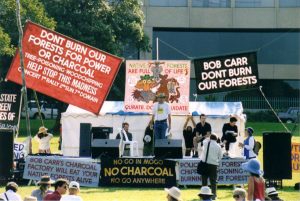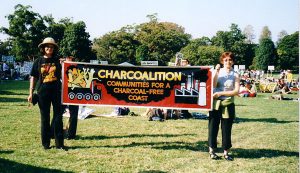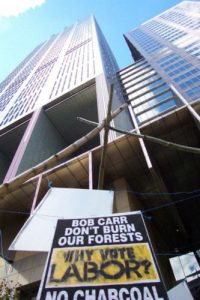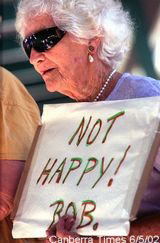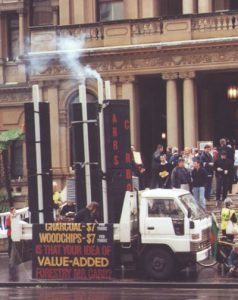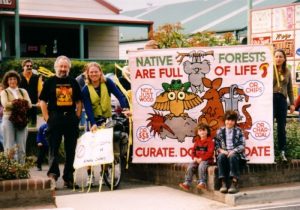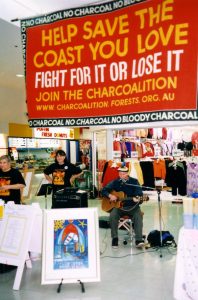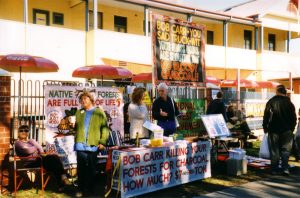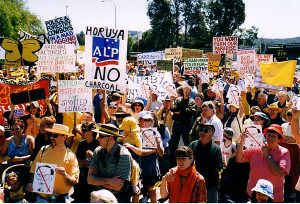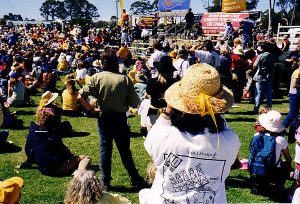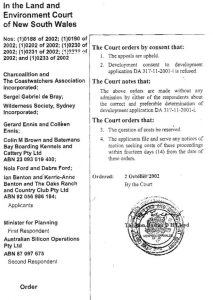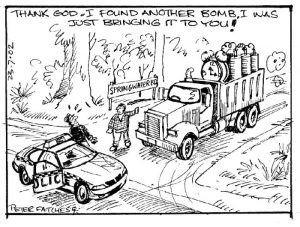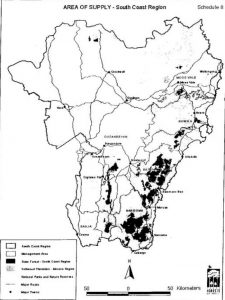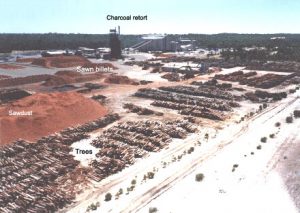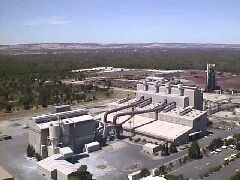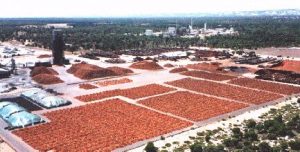Interview with Glen Klatovsky (Wilderness Society) – Transcript published with permission.
AJ-Earlier this week I spoke about the extraordinary circumstances confronting people on the South Coast, who are being treated with contempt by the Premier himself, over the proposal to build a charcoal plant in the little towns of Mogo and Brulee, about halfway between Moruya and Bateman’s Bay.
Now, you know the story. One of the beautiful tourism spots in the world, but the charcoal plant will be on a seventy hectare site. The processing plant will cover four hectares. It will have five chimneys, each eleven stories high. It will operate 24 hours a day, 350 days a year. It will consume about 200,000 tonnes of timber that will be turned into between 30,000 and 35,000 tonnes of charcoal. The charcoal will be taken by road to Lithgow. just — by chance — a marginal Labour seat.
Now, as I said, the charcoal plant is to be built in one of those beautiful parts of the state. Even the Premier has acknowledged that, saying in September last year, “I am delighted to be here in Eurobodalla, the land of many waters, the beautiful South Coast — there’s nothing like it.” Well, there won’t be anything like it after the plant is built.
Remember I told you that during the application process for the plant, Planning New South Wales received 1,530 submissions. They came from 1, 220 individuals and groups. Fewer than twenty were in support of the plant. But, the government ignored the public — Hunter’s Hill revisited.
But let’s put that aside for the moment. I’ve received many communications relating to a series of emails which, according to the opposition in New South Wales, suggested the government was prepared to pull the pin on the charcoal plant if news emerged of a tree poisoning program on the South Coast.
Can you believe this? Fred Niles said the government has lied over Hunter’s Hill. It’s a hard word to use. Well, listen to this farrago of lies — this is ICAC stuff.
On September 18 of last year, Lee Rhiannon of the Upper House asked Minister Kim Yeadon if State Forests had halted the poisoning of trees. Let me just take that proposition in itself. Australian Silicon and State Forests keep saying no tree will be cut down for the sole purpose of charcoal production. Now that in itself has created controversy. But opponents of the plan say the statement means nothing because there are many reasons why a tree could be cut down. Let’s face it — the charcoal plant will consume 200,000 tonnes of timber a year. The wood has to come from somewhere. And, it’s said that the trees have to be transported to the plant, and the charcoal transported away from the plant. 20,000 additional heavy truck movements a year on the Princess Highway. Nice stuff.
But back to the business about no tree will be cut down for the sole purpose of charcoal production. What does that mean — sole purpose? On September 18 of last year, Lee Rhiannon of the Upper House asked Minister Yeadon if State Forests had halted the poisoning of trees. Mr. Yeadon said it had. Then came a leaked email from Shane Gilbert of State Forests to Virginia Knox of the New South Wales Treasury. (This is one of some 9,000 pages of documents that opponents of the plant are trolling through.) An email says, “Yeadon has put an answer to Rhiannon that the poisoning has been suspended when that is not the case.” In other words, the poisoning occured for at least a month after Mr. Yeadon said it had stopped.
And, of course, a poisoned tree is a tree that has to be cut down — especially when you’re poisoning it yourself.
Now, the opposition is saying that Minister Yeadon, despite his protests that he was talking about another part of the state, has misled Parliament and should be sacked. Shane Gilbert from State Forests allegedly sent an email to Bob Smith, the CEO of State Forests, which said, “In September, I formally wrote to Dodds…” (who was with State Forests at Bateman’s Bay — so much about Yeadon’s argument that he was talking about another part of the state,) “I wrote to Dodds to encourage him to stop the poisoning program as it had the potential to stop the charcoal plant in its tracks and, by definition, the smelter plant in Lithgow.”
Well, we wouldn’t want that happening, would we? Especially in a marginal Labour seat. It appears as though any tactic is a good tactic these days with the Carr Government. The email says, “I knew the acute sensitivities of the Premier and the Treasurer’s Office to these issues, and another stinker of an article in the newspaper would give rise to the direct intervention of the Premier to direct the Minister to direct you” (Smith, the CEO of State Forests) “to terminate the poisoning program on the South Coast.
So, has the government covered up the extent of tree poisoning? And does the cover-up extend right to the offices of the Premier, the Treasurer, State Forests, and the Minister for Forests, Kim Yeadon? Now remember, both State Forests and Australian Silicon have said no tree will be cut down for the sole purpose of charcoal production. But if the trees are dead — from a State Forests poisoning program — then the fuel for the plant is right there on your doorstep.
ALAN JONES: On the line is Glen Klatovsky, the New South Wales Campaign Manager for The Wilderness Society. Glen Klatovsky, Good morning.
GLEN KLATOVSKY: Good morning, Alan.
AJ: Were State Forests poisoning trees?
GK: Absolutely they were. They in fact employed sixteen people, in the region where the charcoal plant will be, to poison trees full-time for around six months. The plan was to go for much longer than that. Luckily, we stopped it eventually.
AJ: And those trees would be then cut down, and they would be the fodder for the charcoal plant.
GK: That’s right, and these people were using serious poisons. Our understanding was that these sixteen men had to get urine samples every Friday afternoon at the end of week to determine whether they had been poisoned themselves. So, this is a very large scale operation and a very dangerous one.
AJ: So you’re saying that when Lee Rhiannon asked Minister Yeadon on September 18 last year if State Forests had halted the poisoning of trees, Yeadon lied to the Parliament.
GK: We believe he lied to the Parliament. We understand that their argument at the moment is that the poisoning continued but in a different region. But, the fact is that other region — the Eden region, which is nearby — is also going to supply timber to the charcoal factory. So —
AJ: Why would you be poisoning trees anyway?
GK: Well, the poisoning started pretty much at the same time as the rumors about the charcoal plant.
AJ: That’s it, so they wanted the timber.
GK: That’s right, so —
AJ: And hence, hence, no tree will be cut down for the sole purpose of charcoal production, so we can cut them down because they’re poisonous.
GK: That’s right. Well, what it is is that they actually reclassified, renamed whole forest areas as waste trees.
AJ: Waste trees.
GK: So there’s a whole heap of forests now on the South Coast standing there quite happily — good habitat, beautiful spots. All those trees are now formally waste.
AJ: Because they’ve been poisoned.
GK: No, not even poisoned. They can be ringbarked or a whole range of other strategies.
AJ: Just reclassify them.
GK: Just reclassify them as waste.
AJ: And that then can be used as fodder for the charcoal plant.
GK: Well, that’s right. The justification for chopping down those trees is because they are now formally waste. So, you chop them down because they’re waste.
AJ: So hence the argument clevery used — not for the sole purpose of charcoal production. We’ve classified them as waste, and we poisoned —
GK: The minute they hit the ground, they are then available for charcoal.
AJ: For charcoal.
GK: They’re not cut down for charcoal, though. They’re cut down because they’re waste.
AJ: And Shane Gilbert of State Forests made contact with Virginia Knox in the New South Wales Treasury, quote: “Yeadon has previously put an answer that the poisoning has been suspended when that is not the case.”
GK: Yeah, that’s right. And you were talking about the 9000 sheets of paper. It’s very clear that Treasury has an important role in the development of the charcoal factory. And it goes not only to those communications but also to huge public subsidies to this industry. So, not only are the people of the South Coast who are opposed to the plant having it forced upon them, but now they also have to pay out of their taxes subsidies to the company to built it.
AJ: Right, and those subsidies may even extend — and I haven’t got on to that issue yet but I will — to the silicon plant at Lithgow.
GK: That’s right, yeah, particularly if —
AJ: If the taxpayer may be underwriting that as well.
GK: That’s right, electricity subsidies.
AJ: Yep. Now, that’s another story. There’s another email from Gilbert in State Forests to Bob Smith, the boss of State Forests, telling him how he had written to a colleague on the South Coast, quote, “to encourage him to stop the poisoning program as it had the potential to stop the charcoal plant in its tracks.”
GK: That’s right.
AJ: So people were behind the scenes telling lies and then worrying that they were going to be found out.
GK: That’s exactly right. The web of lies over this has been enormous, and what we’ve seen is that the lies come back on them. Basically, the people of the South Coast, most of whom would never call themselves Greenies, have seen so many lies over this development that they don’t trust anyone. And they certainly don’t want this development
AJ: So the government at the highest level knew what was going on. It most probably knew that lies were being told. It certainly knew that trees were being poisoned, and it knew that that was a clever use of words — oh, no tree will be cut down for the sole purpose of charcoal production. When they then found out in relation to the poisoning of trees, they reclassified others as waste and they then, therefore, can be cut down.
GK: That’s exactly right, it’s a very clever strategy. And again, out of those 9,000 pages, there are hundreds of pages of emails between different government departments trying to work out the wording that fits the agenda best.
AJ: And, where do we go from here, do you reckon?
GK: Unfortunately for us and for the people of the South Coast, it’s going to end up in court. So, we’re going to spend the next twelve or eighteen months spending vast sums of money trying to stop this development in the courts. And, of course, this is in effect another subsidy because the government will be spending even more grotesque amounts of money trying to win the court case against us. So the government is actually, in effect, in court against the people of the South Coast.
AJ: Yeah, well good luck to ’em. Good luck to them, and they’re welcome. But, the public view is a very strong one, and the public already are expressing their views on all of this. We’ll continue to talk — you feel free to provide any information you have in relation to that to me, and we’ll talk again.
GK: Thank you, Alan.
AJ: In an extraordinary… in a, in a, — there we are. So that’s Hunter’s Hill revisited. Tell lies, do whatever, any tactic will do, any tactic will do. And Bob Carr throwing out some red herrings about what he’s going to do about migrants. Or, he’s going to reform the defamation laws, or try to persuade people that the real problem about public liability is all of you people are racing off for litigation. Or they’re dishonest lawyers or Santa Claus judges.
In a press release way back on May 29, by the Wilderness Society, it said this, quote: “Despite this, forests continue to be poisoned further down the coast.” Further links between tree poisoning and the charcoal plant are made in reference to the board of State Forests, quote: “The State Forests Board has now requested that they be briefed on the herbicide issue and the Lithgow silicon smelter project.”
The clear conclusion to this insidious set of lies from State Forests and the minister over the last eight months is that poisoning is linked to the charcoal plant. That is, whole trees were killed for charcoal production. This exposes the calculating and manipulating lie that no trees will be cut down for the sole purpose of charcoal production.
It went on. It’s clear that both State Forests and their minister Mr. Kim Yeadon have used deceptive means to hide the truth about tree poisoning regimes and the charcoal plant. And when they were then found out, they decided to reclassify timber in the area — even as far south as Eden. Call it unwanted, call it waste, call it reclassified, it can be now cut down to serve their ends.
There must be, it’s clear, no end to which the Carr government won’t go to deny the public and, what’s worse, to deceive it.
***

